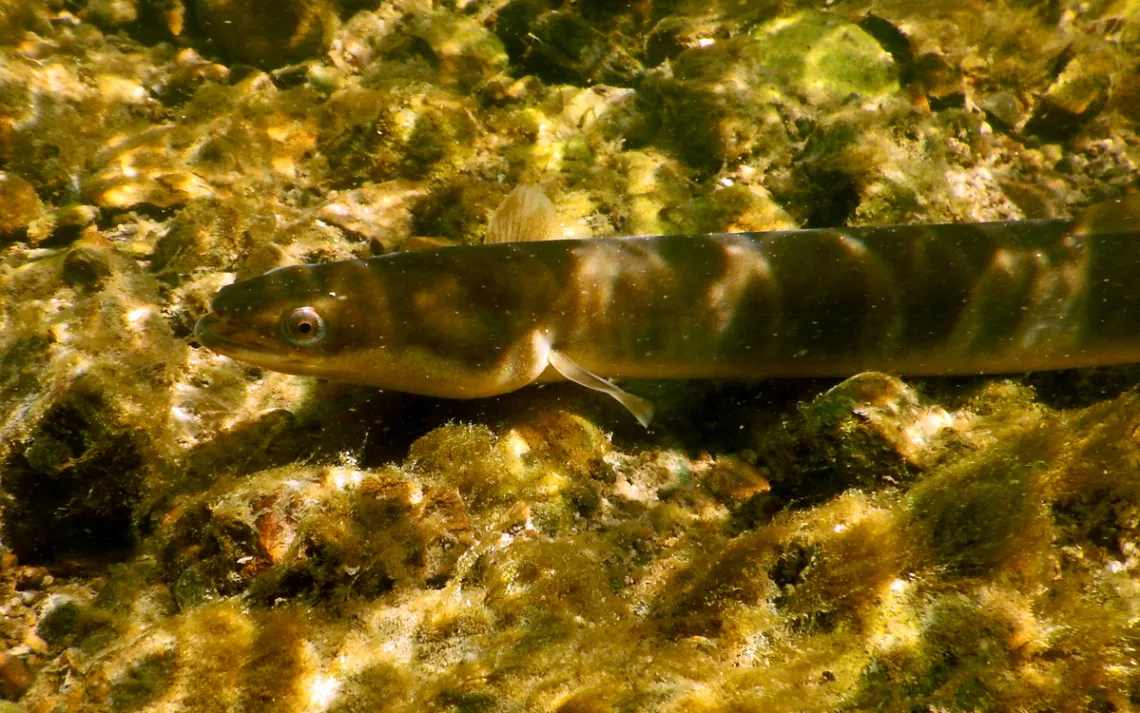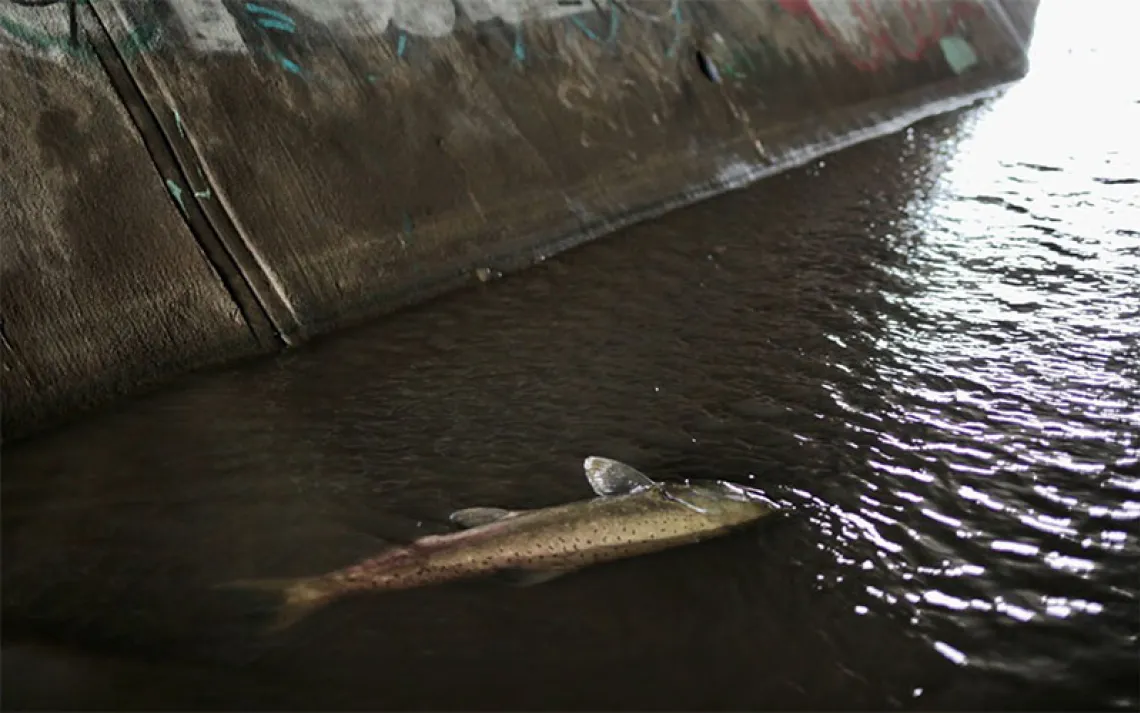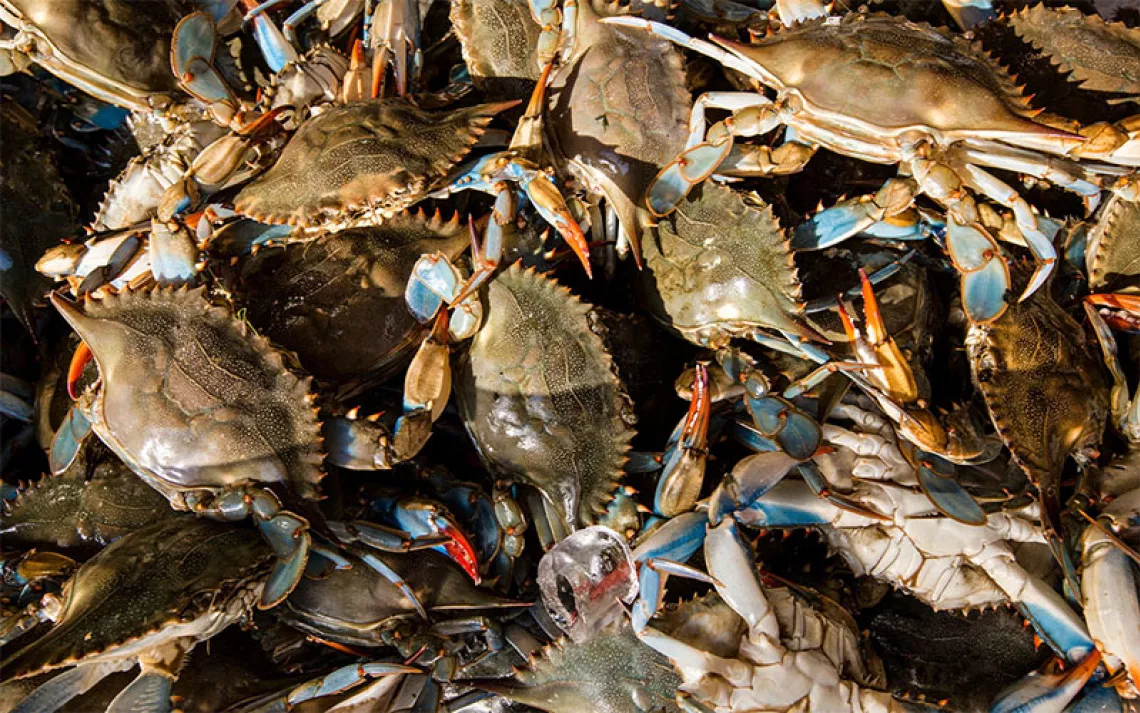This Mysterious Fish Could Rescue East Coast Rivers
Restoring Pennsylvania’s slipperiest species

Courtesy of US Fish and Wildlife Service
Just as rural Pennsylvania’s Amish farmland turns to coalfields, there's a wide stretch of the Swatara Creek—the Swatty, to locals—that's popular with anglers and kayakers. Although quiet now, a century ago it was home to one of the largest commercial fisheries in the east. Swatara is derived from a Susquehannock word that means "where we feed on eels." The creek used to teem with them—hundreds of thousands of American eels, making their way up the Swatty and other tributaries of the Susquehanna River.
For millennia, the eel was a staple in the American diet. On moonlit nights, weirs on the Susquehanna once captured them by the ton. In the early decades of the 20th century, however, hydroelectric dams sprang up throughout the region, blocking passage for the eels, whose populations plummeted. The commercial and recreational eel fisheries dried up, and the ecosystem suffered.
But in recent years, environmental agencies have launched a widescale recovery mission. American eel populations are booming again; in the Susquehanna basin, they're being found in higher numbers than scientists have seen in decades.
“Eel habitat basically covers the entire East Coast, from the Mississippi basin to Canada,” says Sheila Eyler, project leader with the US Fish and Wildlife’s Mid-Atlantic conservation office. “They have such a wide range. What we’ve seen in the Susquehanna shows the population can persist, if we can work on the local issues.”
*
The most interesting thing I know about eels is just how little we know about them. Eel species are found all over the world and have been an important global food source for millennia, but there’s a lot about eels that continues to elude scientists. For a long time, the biggest mystery was, where do they come from?
Ancient Egyptians associated eels with creator and sun god Atum of Heliopolis and thought they were generated when the sun’s rays fell on the Nile. Aristotle, noting that ponds filled with eels after a good rain, decided they came from the mud, or maybe were metamorphosed earthworms. As a university student, Sigmund Freud dissected hundreds of eels, searching for genitals that would prove they reproduce sexually.
Today, scientists can confirm eel reproduction is sexual, differentiating males and females with gonads that develop once the eels reach maturity. And, thanks to Danish biologist Johannes Schmidt, we know where it happens. Beginning in 1904, Schmidt spent close to 20 years chasing eels, trawling the Atlantic for smaller and smaller larvae. Eventually, he discovered that all American and European eels originate in the Sargasso Sea, a region between major currents in the Atlantic Ocean off the coast of North America. Perhaps it’s unsurprising, given all the mystery surrounding eels, that they spawn in the Bermuda Triangle.
Scientists now agree on the eels’ point of origin. “They’ve managed to follow them back to approximately where they’re spawning,” says Sarah Coney, an aquatic biologist with the Catskill Regional Invasive Species Partnership, “but nobody has ever seen it.” Even aquaculture operations “haven’t figured out how to breed them,” Coney adds. Instead, eel farms import glass eels—fish just past the larval stage that look like transparent earthworms.
Eels arriving from the Sargasso Sea at the mouth of the Susquehanna are glass eels, which swim upstream to the tributaries where they’ll live for close to 20 years. At first, they’re subject to predation, says Eyler. “Catfish, smallmouth bass, muskie, walleye; they’ll all eat little eels. But once they get up to around two feet, they’re getting to be one of the biggest fish in the system.” And by the time they’re ready to swim back downstream and return to the Sargasso, American eels can be four feet long.
Once, those massive creatures “made up a huge percentage of the fish biomass in the Susquehanna,” says Coney. They were a major player in the food web. But within 100 years of the 20th-century hydroelectric dams that blocked the eels’ passage, they were almost nonexistent in the river.
In many ways, Susquehanna eels owe their recovery to another species, the Eastern elliptio mussel, a palm-size bivalve with a dark-green shell that can live for the better part of a century. In eastern rivers, the mussels perform important ecosystem functions, including water filtering and nutrient cycling.
“They’re important for sediment stabilization, and a major food source for animals,” says Coney. Several decades ago, she says, the river bottom was covered with “huge, huge beds, with hundreds of thousands of individuals. Now, in the Susquehanna, you can go long stretches without seeing them.”
In the mid-aughts, says Eyler, “we began wondering why this mussel that’s very common in the rest of the Delaware River basin wasn’t in the Susquehanna.” To distribute themselves in a watershed, baby mussel "seeds" need to catch a ride upstream on the gills of a fish, and scientists began to suspect that the missing mussels were tied to another species.
“Eastern elliptio mussels are what we call broadcast spawners,” says Coney. “They just put all the larvae (called glochidia) into the water column and let it go.” But while many fish may swim through the cloud of seed mussels, only specific species are suitable hosts. To solve the mystery of why the Eastern elliptio was disappearing from the Susquehanna, Eyler says, the first step was finding its host.
Lab studies, which involved putting different species of fish in tanks with spawning mussels, found that though perch and trout would pick up some glochidia, another fish was the clear winner. For the Eastern elliptio, the most common native freshwater mussel in the region, there's no better buddy than the American eel. To restore one species to the river, they’d need to bring back both.
*
To boost the population of eels, biologists had to figure out how to get them beyond a major obstacle on their path upstream: the Conowingo Dam, just above where the Susquehanna meets th Chesapeake Bay.
“This is the biggest river on the East Coast that eels don’t have access to,” says Eyler. “So, we started to ask, How do we open it up? We probably started trying things in 2005, but really figured it out by 2008.” There was an existing fish elevator in the dam, Eyler says, with a screened gate that pushes fish into a hopper to be lifted into Conowingo Pond. But the eels trying to get upriver are at the beginning of their life cycle.
“They’re small,” Eyler says. “They swim into the collection area, but when the gate pushes forward, the eels swim right through it.” Starting in 2005, the Fish and Wildlife Service partnered with the Susquehanna River Basin Commission and the operator of the Conowingo hydroelectric project to install an eel passage system, building what Eyler calls an “easy and cheap” contraption to collect juvenile eels.
“You just buy an aluminum cable tray, and in the bottom, you put this cloth they use for erosion control. It’s like a plastic mesh,” she says. “You use a trickle of water to keep it damp, and the eels climb right up, then fall over an edge into a collection tank.” The eel tanks are loaded into trucks, driven around the dams, and released. The simple solution has been wildly successful. “There’s been over 2 million eels collected and moved upstream since 2008,” says Eyler. “Some years are better than others, but 2021 was the best we ever had—600,000 eels.”
That’s nearly twice the total collected in the next-best year, says Aaron Henning, fisheries biologist with the Susquehanna River Basin Commission. “All those eels are going into the system as one- and two-year-old fish, and living their lives in the Susquehanna, performing those ecological functions they haven’t been able to do for the better part of a century.”
In short, it worked. The eels released in the river’s main stem have spread all the way through the river system, Eyler says. “They’re going as far as New York—before we stocked any there, we already had reports of eels way up in the headwaters.” And the mussels are returning too.
Starting at the time of the first eel stocking, biologists have conducted annual mussel surveys in some of the Susquehanna’s tributary creeks. “We went back every year to those mussel beds, which only had very old mussels in the first surveys,” Eyler says. “After five years, there were baby mussels. Having the eels there is helping, which is fantastic news.”
It’s progress, says Eyler, but trucking eels upstream around the dams “is a Band-Aid, not a long-term solution.” The eel contraption only works in one direction. The dams still represent a major problem for mature eels from the earliest years of the stocking program that are now trying to migrate back out to saltwater.
“If we’re going to have a truly successful reintroduction, they’re going to need to out-migrate,” says Henning. There are no passage systems on the downstream-flowing side of the Susquehanna’s dams. “When out-migrating, they’re several feet long, not several inches,” Henning adds. “They can’t swim easily through the turbines, and there’s a lot of mortality.” That’s the next hurdle, says Eyler, and one her office has begun studying. “We’re interested, of course, in downstream migration and the survival of those eels.”
In the Susquehanna, the American eel has recolonized a long stretch of its ancestral home, and the potential ripples are wide. If they can reach their spawning grounds, their offspring will return not just to this river but to waterways all along the East Coast. It’s the ultimate goal of the scientists who love them for the mysterious, serpentine creatures they are.
For now, above the dams, the eels await a return to the sea.
 The Magazine of The Sierra Club
The Magazine of The Sierra Club



